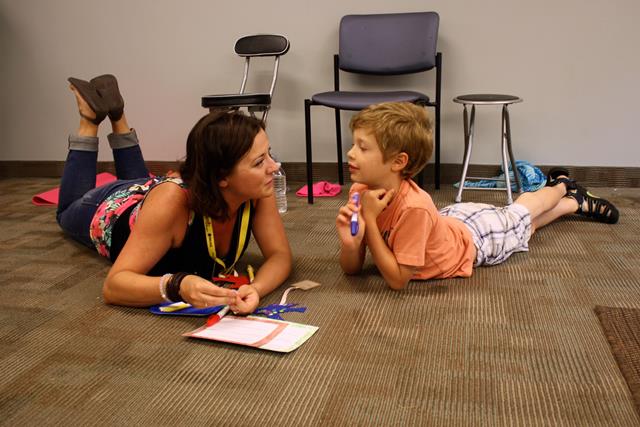
By Helen Reilly
The careful attention Linda dedicates to each detail of her sculpture, brings a sense of peace and accomplishment to her face. Her smile and outlook reveal an optimism that does not reflect her reality – that she is coping with profound grief since the loss of her husband, after a brief illness, earlier this year.
Linda considers herself fortunate to have access to Hospice Wellington’s Grief and Bereavement Art Therapy program. Since she and her husband moved to Guelph, Ontario less than a year before his diagnosis, she did not have a strong network to rely on for support following his death after a brief illness.
Linda suggests it is contact with other grievers – people who truly understand what she is going through – that supports her through her journey. She is surprised by how invested she is in her sculpture as it takes shape week to week, with the therapeutic guidance of Nicole Fantin, Art Therapist, Hospice Wellington. “It’s like a magic combination that surprised me – there’s such a sense of accomplishment in it,” she says.
Comparing her husband’s death in hospital to that of a family member’s recent death in hospice, Linda calls the two ‘polar opposites,’ saying the hospice’s home-like environment “makes the last period of time feel normalized – somehow, it takes away the fear,” she says.
Rami Shami, Director, Community and Volunteer Services, Hospice Wellington reinforces the fact that, “environment is the cornerstone of hospice palliative care,” suggesting it is the home-like environment and the support one receives in that environment – be it, in an individual’s own home or in a community hospice – that changes the experience of how we die. “It determines how our journey is navigated and experienced – but also, and importantly, how it is witnessed by others.”
With only three in 10 Canadians having access to hospice palliative care in their communities when they need it, coverage across the country is inconsistent. As well, a lack of awareness regarding the services that constitute palliative care, where, how and when to access them, remains a barrier to care.
Ontario’s Auditor General noted in her 2014 report that hospice beds were unevenly distributed and that 260 palliative care beds in hospices and hospitals across the province fell far short of the 1,350 beds required to cost-effectively meet the needs of individuals requiring palliative care.
The Canadian Cancer Society’s Right to Care: Palliative Care for All Canadians report, published earlier this year, suggests improvements are needed in Canada’s costly and inconsistent patchwork of palliative care which inadequately supports individuals and families and does not support the health system’s sustainability.
John Fraser, MPP, Ottawa South & Parliamentary Assistant to Ontario’s Minister of Health and Long Term Care, authored the Palliative and End-Of-Life Care Provincial Roundtable Report which is helping Ontario develop a comprehensive strategy on palliative and end-of-life care – one that is focused on supporting families, caregivers and ensuring access to coordinated quality care where patients want to receive it. Given John Fraser’s whole-hearted dedication to this work, Linda says, “aren’t we lucky to have him?”
Fraser’s report laid the groundwork for a Ministry decision to dedicate $75 million to hospice palliative care over three years to improve community-based hospice palliative care services, supporting 20 new hospices across Ontario and increasing funding to existing facilities. The funding increases support for caregivers, helping individuals remain at home or in the community longer, promotes advance care planning and establishes the Ontario Palliative Care Network to advance patient-centred care and develop provincial standards to strengthen services.
Community-based residential hospice programs and visiting hospice programs are available free of charge to individuals with life-limiting illness and their families across the province. Relying on donors and volunteers, hospice offers specialized care wherever individuals wish to receive it. The cost of care in a community hospice, which is covered by the Ministry is $460 per day (excluding drug costs) which is dramatically less than the $1,100 provincial average daily cost of providing palliative care in an acute care hospital bed. Individuals can also receive this specialized care in the comfort of their own home, at a cost to the Ministry of under $100 per day, where at-home care is provided and available.
The late Dr. Dorothy Ley, an early leader of hospice in Ontario, believed spiritual care and the role of volunteers were at the heart of hospice. Volunteers play an essential and critical role in the delivery of care, regardless of the setting. As such, the province is also partnering with Hospice Palliative Care Ontario to provide training that will build volunteer capacity throughout the province.
It is through individuals like Linda that we learn about the value of hospice palliative care for the sustenance of our health care system, for improved quality of life for individuals with life-limiting illness, their caregivers and families.
Helen Reilly is a freelance writer, specializing in health communications.

